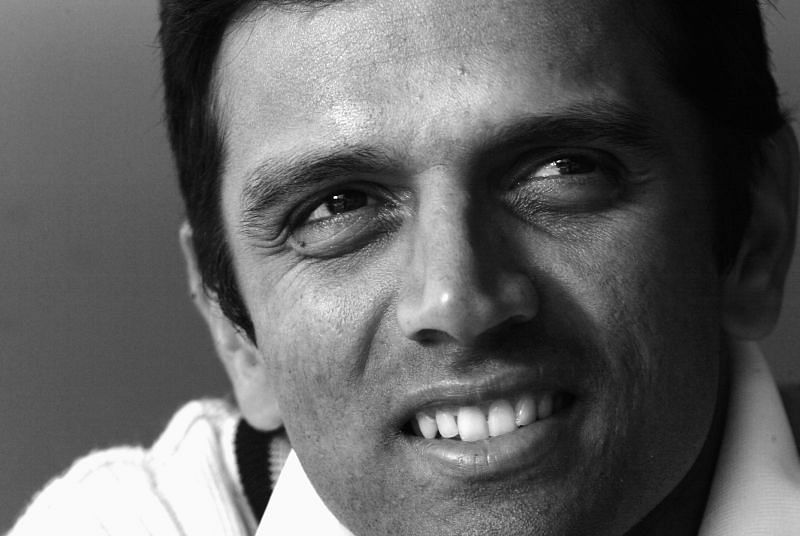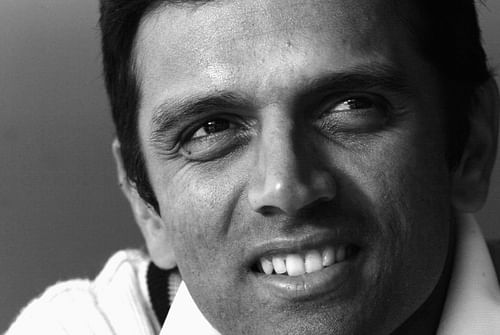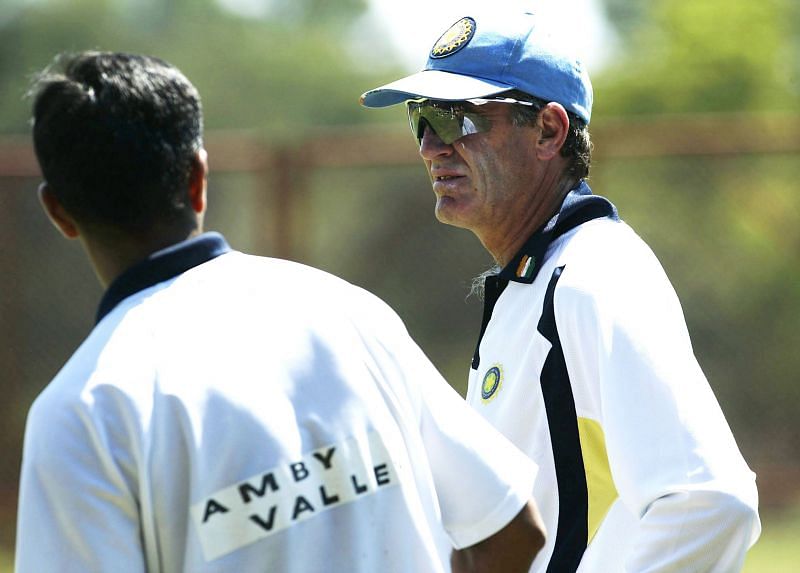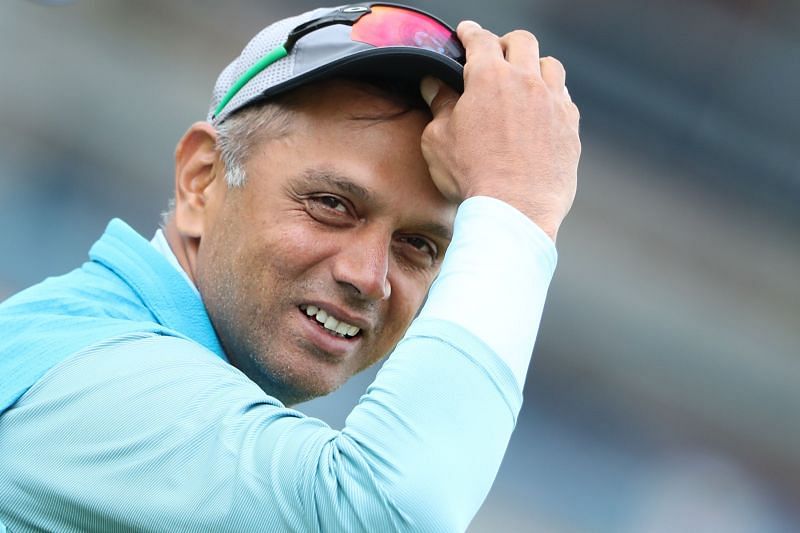
The Rahul Dravid we fail to praise

Singapore 1996. Days after the colourful glitzy extravaganza in the form of the World Cup in the subcontinent, India, Sri Lanka and Pakistan locked horns in the Singer Cup. Back to sporting the whites and switching from the white to red ball, the island nation’s little cricket ground hosted the three Asian giants.
Sanath Jayasuriya had mauled Pakistan in the first game, recording the then fastest ODI hundred. The next morning, the newly crowned World Champions’ menu read India, the side they had steamrolled in the two World Cup games including the semi-final.
India just about managed to win this by 12 runs.
More importantly, the match introduced India to a name they saw in the headlines and bulletins for his domestic exploits. A lean 23-year-old, sporting a light moustache, who went by the name Rahul Dravid, batted for India at number four without much success.
Rahul Dravid's international debut
Over the next many changed calendars, the name would climb through the steepest stairwells to incredible heights, crafting a legacy and emerging as one of India’s favourite sons.
Parallel to his methodical rise in cricket, Rahul Dravid, at different junctures in his journey, could fit into any of these templates: a studious monk, the likeable introvert, an advertiser’s delight, the poster on every teenaged girl’s wardrobe, the eligible bachelor, the ideal husband, the best batsman, the selfless team man, the impeccable orator, the tactician, the underrated leader, the fine analyst, the inspirational mentor, the visionary, etc.
Writers and fans have probably exhausted all the positive adjectives to describe Rahul Dravid’s nicety and greatness – which generally oscillates between his remarkable batsmanship and gentlemanliness (also read that as the perfect team man).
A chunk of his legacy in Indian cricket is perhaps so trapped in the brand-painted and media-portrayed images of being the epitome of goodness that it eclipses his tactical acumen and other vital contributions.
Let’s look at four such aspects giving a break to his batting mastery.
Rahul Dravid – as team man as his teammates, but a captain with a difference
Statistically, Virat Kohli is India’s most successful Test captain. In Indian cricket when you discuss the greatest captains, the discussions usually end with a debate of divided opinions between Sourav Ganguly and MS Dhoni with a section of baby boomers mentioning MAK Pataudi or Ajit Wadekar.
Rahul Dravid’s name never finds a mention here. Why? Again the overshadowing perceptions of out-of-the-world batsman and a perfect team man (whatever it means).
There were no imperfect team men around.
When Ganguly became the captain, he made Dravid bowl off-spin in ODIs and later got him to keep wickets. The captain was being as team man trying to balance the side by maximizing a player’s potential.
Ganguly was as team man in sacrificing his opening slot to accommodate Virender Sehwag. The latter did the same in Tests by becoming an opener by risking his middle-order berth.
Anil Kumble, India’s premier spinner, often spent days in the sidelines after losing the one-spinner spot to Harbhajan Singh in an overseas Test. Though disgruntled, he would be the ideal team man, relentlessly help youngers train.
Everyone was a team man, but not everyone was as brilliant with tactics as Rahul Dravid.

If an all-time Indian XI was touring overseas, Dravid could be a captaincy contender after Kohli (and yes, before Dhoni).
The 2007 World Cup exit blotched his reputation as a captain, and so did Greg Chappell’s overpowering persona as the coach. A year back, what had marred his reputation was losing a home Test against England and then India’s dismal Champions Trophy.
But Rahul Dravid wasn’t afraid to experiment with the batting order (Remember, Irfan Pathan?) or setting unconventional fields. Had Greg Chappell been a good man-manager and the team remained a happy unit, Dravid’s side could have achieved more.
Nevertheless, under Dravid India chased well in ODIs. He masterminded a winning streak of a record 17 consecutive successful chases. In the meantime, MS Dhoni grew into a more versatile player.
In 2006, Dravid became the first Asian captain to win a Test series in West Indies in 35 years. And he led from the front with two brilliant knocks in a difficult Sabina Park pitch. Two years prior, as the stand-in skipper, he became the first Indian captain to lead a side to a Test win in Pakistan. Later in 2006, he led India to their first Test win in South Africa. He also became the first Indian captain to win a Test series in England in 21 years.
Coming to least spoken-about decision that changed the course of Indian cricket. He was the Indian captain but decided to opt out of the inaugural T20 World Cup in 2007. He convinced Tendulkar and Ganguly to do the same. The rest is history.
Already into the mid-30s, he didn’t see his likes owning the new format at the international level. When he saw Dhoni’s meteoric rise as a leader, he stepped down from captaincy, surprising many.
He had a slow start to the IPL as the first captain of Royal Challengers Bangalore (RCB). Vijay Mallya’s extravaganza would have never found its ideal match in the methodical Dravid, who hadn’t yet found the T20 formula. A few seasons later, he did and led Rajasthan Royals brilliantly.
Rahul Dravid was MS Dhoni’s ideal predecessor
To be a competitive unit in ODIs, Sourav Ganguly wanted a wicketkeeper who could play as a batsman – a rare breed in the early 2000s. Rahul Dravid had never kept full-time since he was 15 and would occasionally don the gloves for India, if required.
He was still an important member of the ODI side that comprised Tendulkar and Ganguly, and the upcoming talents like Sehwag and Yuvraj.
For the sake of balance, Rahul Dravid nodded to the role. One of the finest catchers in the slip, Dravid knew how to pouch them, but things can get different with the gloves on and keeping is mostly about the feet movement.
From the Kirmanis to the Sahas, we know how supple feet make a difference. Dravid’s work behind the stumps was far from alluring but was effective. Probably, the keeping drills improved his fitness levels and Dravid’s batting scaled during the keeping days.
Dhoni, who brought Dravid the greatest relief, debuted in 2004 and in the next 15 years, piled up 10,773 runs from 350 ODIs at 50.57 and a strike rate of 87.6.
Before that, Dravid kept in 73 ODIs, scoring 2,300 runs at 44.23 and they came at a decent strike rate of 72.6.
Apart from Dravid and Dhoni, the only Indian keeper to score an ODI hundred is KL Rahul. Only Nayan Mongia and Kiran More are the other Indian keepers with over 500 ODI runs and their averages read 20.2 and 13.1, respectively.
Trivia: Dravid has a 22-ball half century in ODIs. It’s India’s joint second-fastest fifty in the format and fastest by an Indian wicketkeeper.
Dravid, the ODI player was equally invaluable.
Rahul Dravid – the champion against swing
Rahul Dravid was recently voted the best Indian Test batsman in a Wisden poll. The voters went by emotions more than facts because Sachin Tendulkar clearly has been India’s best batsman in the longer format. But Rahul Dravid had his days, (or years).
Tendulkar’s career suffered a slump in 2003. Later, a tennis elbow bothered him. Dravid was India’s best batsman between the two West Indies tours of 2002 and 2006. During that phase, he averaged over 68 in 49 Tests. By mid-2006, Dravid’s Test average had climbed to 58.75.
For all the talks of intent and ridiculing zen-like efforts of concentration, the recently concluded Sydney Test makes you believe otherwise. With Dravid, such moments came across the world. He could stay at the wicket.
Rahul Dravid had his struggles against good pace and bounce that saw him in discomfort in Australia and South Africa. But he would toil, take the shine off the ball and tire the strike bowlers for the rest of the line-up. He played that role well.
But Dravid’s prowess against the moving ball was better than Sachin Tendulkar, Brain Lara, Ricky Ponting, Steve Waugh, Shivnarine Chanderpaul, Jacques Kallis and Inzamam-ul-Haq.
Rahul Dravid - 148 at Leeds: One of the finest knocks by an Indian
Rahul Dravid almost averaged 67 from the 20 Tests he played in England and New Zealand, conditions known to be the paradise for swing bowlers.
Among players who have played in both England and New Zealand and scored 1,000 runs, only Seymour Nurse (West Indies) and Steve Smith (Australia) have a better average than Dravid. Smith averages 70 from his 16 Tests, whereas Nurse 81.5 from his eight Tests.
A modern great like Virat Kohli also averages in the mid-30s in the two nations.
Even at 39, batting out of number, Dravid would score three hundreds in four Tests in England, while his younger colleagues struggled against the guile of James Anderson and Stuart Broad. India lost the series 0-4.
India’s 2002-03 tour of New Zealand was one of their worst. India had barely managed to cross 500 collectively from their four innings. In the seemingly unplayable surfaces, Dravid would score almost a fourth of India’s runs.
Hail Rahul Dravid's vision over the subjective 'goodness'
The utterance of the phrase: ‘true gentleman of the game’ pops up Rahul Dravid’s image in one’s mind. Goodness is subjective. Dravid is sober, articulate and humble. Admirable qualities. But problems lie in comparisons. There is no evidence to gauge Dravid’s goodness and pit it against Kohli’s and measure the two.
Similarly, there’s no reason why Rahul Dravid will surely be a better coach of the national side than Ravi Shastri. Again perceptions. Shastri and Kohli are outspoken, and Dravid is not.
Let’s drift a bit.
When on the field, Hansie Cronje embodied the spirit of the game. Remember, he once recalled Ganguly after the Indian cricketer got run out after accidentally bumping into his players. But then Cronje will be remembered for something that tarnished the sport.
Contrastingly, Dravid had appealed for obstructing the field against an unsuspecting Inzamam, getting him dismissed. Something a Cronje would never do. Then there was the ball-tampering controversy.
In an interview with Gaurav Kapoor, Dravid even joked about his image and said,
“I am a human. I am going to make mistakes. Don’t blame me when I make those mistakes.”
In 2018, Rahul Dravid’s mentorship was singled out by many as the Under-19 Indian team won the World Cup. Roger Binny, Dav Whatmore and Bharat Arun had coached Indian U-19 teams to victory, but very few mention them.
There’s much more to the perceived goodness.
What makes him unique is his vision. His role in planning, strategising, organising and honing of skills of the talented products has helped India create a great supply line.

Rahul Dravid has always refrained from overpraising teenagers. As a coach at the junior level, he has helped them plan, improve and instil responsibility. If you scan through any recent A-team or U-19 tournaments, the differentiator won’t be the skill-set. Rather it would be the maturity the Indian boys display along with the doggedness to finish off games.
As a result, India get many Test-ready players. From Shubman Gill to Prithvi Shaw to Hanuma Vihari, these guys have been conditioned for the top level, and it’s apparent in their approach.
Not many stars have openly spoken against issues plaguing junior cricket. Rahul Dravid has. And he has made the administrators introspect and act.
From age-fudging in junior cricket to how the academies treat young players, Dravid has been vocal. He also expressed concerns and asked BCCI to pen strict guidelines on what a child does in an academy. He provided examples on how a nine-year-old are often made on bowl on 22-yards which is challenging for their body. He also spoke at length about how some parents create a cricket obsession, and the child invests so much emotionally that he ends up struggling, thinking the family’s future depends on his cricket.
Similarly, he has lashed out on the system and called out coaches who let kids with faulty bowling action pass through different age-groups in greed to win. Their wards get called for chucking at senior level, which hampers their progress and threatens the career pathway.
As an experienced international cricketer, Dravid understands the emotional turmoil involved with the sport and helps the youngsters with the same. Time and again, he has cleared his intention to contribute at the grassroots – be it as a junior coach or at the National Cricket Academy (NCA).
If Rahul Dravid becomes the senior team coach that will defeat the whole purpose of him wanting to coach in itself, creating the supply line and a strong bench.
A cricketer who played by the copybook, he lets the free-flowing likes of Rishabh Pant or Kamlesh Nagarkoti flourish with their own tested methods. It was apparent during his captaincy that he allowed the freedom to a young Dhoni and helped someone like a Yuvraj shoulder more responsibility.
Rahul Dravid is much more than his perceived image and needs also to be celebrated for the same.